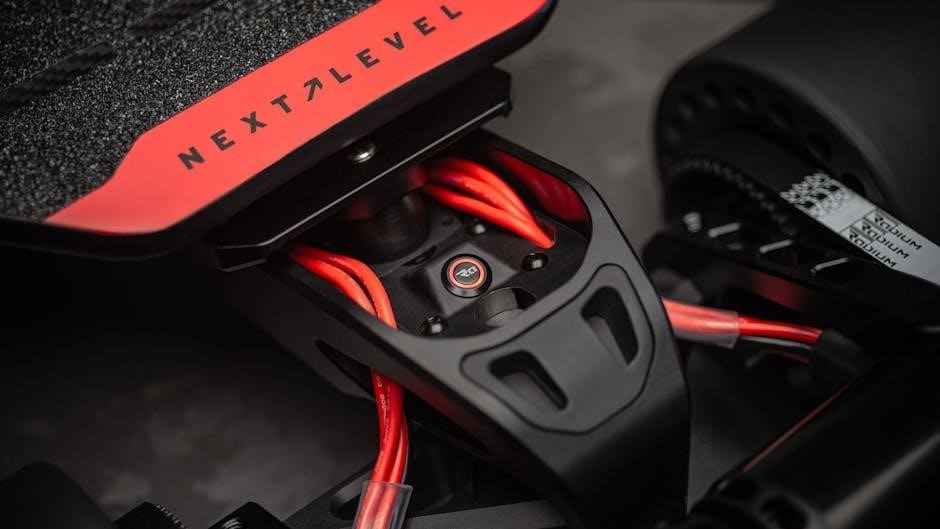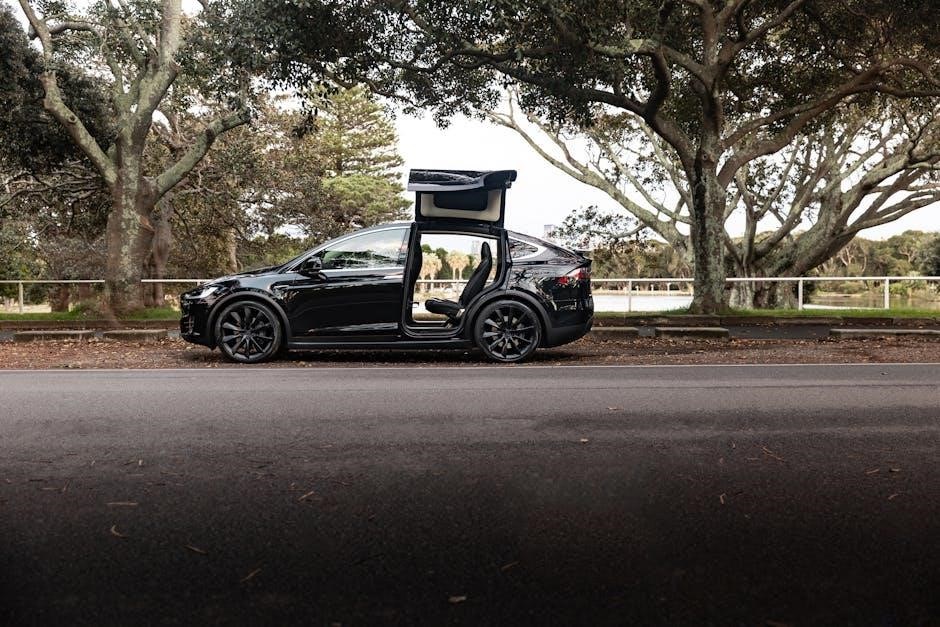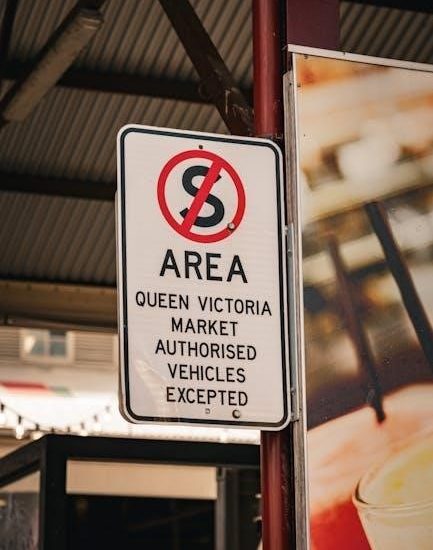The use of lithium batteries in Australian caravans is regulated by strict safety standards, primarily AS IEC 62619, ensuring safe installation, monitoring, and preventing risks associated with their use.
1.1 Overview of Lithium Battery Use in Caravans
Lithium batteries are increasingly popular in Australian caravans due to their high energy density, longer lifespan, and faster charging capabilities. Their use is governed by strict regulations to ensure safety and reliability. Compliance with AS IEC 62619 is mandatory, requiring proper installation, monitoring, and protection systems. External installation in well-ventilated compartments is essential to mitigate fire risks. Monitoring devices must display state of charge and other critical metrics. These batteries offer significant advantages over lead-acid alternatives, making them a preferred choice for modern caravan setups, despite requiring careful handling and adherence to safety standards.
1.2 Importance of Safety Standards
Safety standards for lithium batteries in caravans are critical to preventing hazards like thermal runaway, fires, and explosions. Compliance with AS IEC 62619 ensures batteries are designed and installed to minimize risks. A Battery Management System (BMS) is essential to protect against overcharging, overheating, and short circuits. These standards also address proper ventilation and external installation requirements, reducing the likelihood of incidents. Non-compliance can lead to insurance voidance and legal consequences, making adherence to safety protocols paramount for both manufacturers and caravan owners to ensure reliable and secure energy storage solutions while on the road.

History and Evolution of Lithium Battery Regulations
Lithium battery regulations in Australia have evolved significantly, with key updates in November 2023 and January 2024, driven by safety concerns and technological advancements.
2.1 Key Milestones in Regulatory Development
Australia’s lithium battery regulations have seen significant milestones, including the adoption of AS IEC 62619 standards and the November 2023 mandate requiring compliance for caravans built after this date. Incidents like the January 2024 caravan fire highlighted the need for stricter enforcement, particularly in Western Australia. These developments emphasize external installation requirements, mandatory BMS integration, and state-specific fire safety protocols, ensuring safer lithium battery use in caravans and motorhomes nationwide.
2.2 Impact of Technological Advancements
Technological advancements in lithium batteries have driven safer and more efficient energy storage solutions for caravans. Improved Battery Management Systems (BMS) and monitoring devices ensure better control over charging and discharging processes. These innovations have led to updated regulatory standards, such as AS IEC 62619, which now mandate external installation and state-of-charge monitoring. Advances in thermal management and fire prevention technologies have also reduced risks, aligning with stricter safety protocols. These developments have influenced regulatory updates, ensuring lithium batteries meet modern safety and performance expectations in caravan applications across Australia.

Safety Standards for Lithium Batteries in Caravans
Lithium batteries in caravans must comply with AS IEC 62619, ensuring safe operation and protection against hazards. These standards mandate proper installation, monitoring, and ventilation to prevent fires and explosions.
3.1 AS IEC 62619 Compliance
Compliance with AS IEC 62619 is mandatory for lithium batteries in caravans, ensuring they meet strict safety and performance criteria. This standard requires lithium batteries to be equipped with a Battery Management System (BMS) to prevent overcharging, overheating, and short circuits. Additionally, batteries must be installed in non-habitable areas, such as external compartments, and be monitored externally using wired or wireless devices. These measures aim to minimize fire risks and ensure safe operation. Compliance with AS IEC 62619 is critical to avoid insurance voidance and legal consequences, as outlined in the updated regulations for caravan lithium battery installations.
3.2 Role of Battery Management Systems (BMS)
A Battery Management System (BMS) is essential for ensuring the safe and efficient operation of lithium batteries in caravans. It monitors and regulates voltage, temperature, and state of charge, preventing overcharging, overheating, and short circuits. The BMS integrates with the battery pack to provide real-time data and protection, ensuring compliance with safety standards like AS IEC 62619. It also balances cells to maintain optimal performance and longevity. A functional BMS is critical for preventing hazards such as fires or explosions, making it a mandatory component in all lithium battery installations for caravans.

Installation Requirements for Lithium Batteries
Lithium batteries must be installed externally in caravans, behind walls or in separate compartments with proper ventilation. This ensures compliance with safety standards and prevents fire risks.
4.1 Prohibited Areas for Installation
Lithium batteries cannot be installed in habitable living areas of caravans or camper trailers, as per the new standard. This includes inside the caravan itself or in areas where people sleep or live. The regulation aims to minimize fire risks by ensuring batteries are placed in well-ventilated, non-living spaces. Western Australia has emphasized strict enforcement of this rule due to high fire safety concerns, with an average of three house fires weekly linked to lithium batteries. Proper external installation is mandatory to avoid insurance issues and legal penalties. Compliance ensures safety and adherence to AS IEC 62619 standards.
4.2 External Installation Guidelines
External installation of lithium batteries in caravans must follow specific guidelines to ensure safety and compliance. Batteries should be placed in a well-ventilated area, such as behind a wall or in a separate compartment, away from living spaces. The standard defines external installation as being outside habitable areas, reducing fire risks. Proper compartmentalization and ventilation are crucial to prevent thermal runaway. Manufacturers must comply with these guidelines for caravans built after November 2023. External installation helps protect against hazards and ensures adherence to AS IEC 62619 standards, minimizing risks associated with lithium battery use in RVs and caravans.
4.3 Compartment and Ventilation Requirements
Lithium batteries in caravans must be installed in a dedicated compartment with adequate ventilation to prevent thermal runaway and reduce fire hazards. The compartment must be sealed but allow airflow to dissipate heat. Proper ventilation ensures gases are expelled, minimizing explosion risks. Battery management systems (BMS) monitor temperature and voltage, enhancing safety. Non-compliance with these requirements can void insurance and render the caravan illegal. Adherence to AS IEC 62619 standards is crucial for safe installation and operation, ensuring protection for both the caravan and its occupants.
Battery Management Safety Systems
Lithium batteries in caravans must be equipped with a battery management safety system (BMS) to protect against overcharging, overheating, and short circuits, ensuring compliance with AS IEC 62619 standards.
5.1 Design and Functionality
The battery management safety system (BMS) is designed to monitor and control lithium battery operations, ensuring optimal performance and safety. It protects against overcharging, overheating, and short circuits by regulating voltage, current, and temperature levels. The BMS also balances individual cells within the battery pack to maintain uniform charge and discharge rates. Compliance with AS IEC 62619 standards ensures the system integrates advanced safety features, such as automatic shutdown in case of anomalies. This functionality is critical for preventing fires and explosions, making it a mandatory component in caravan lithium battery installations.
5;2 Integration with Battery Packs
The BMS must be seamlessly integrated with the lithium battery pack to ensure proper monitoring and control. It can be built into the battery pack or added as a separate component. The system monitors voltage, temperature, and state of charge in real time, ensuring balanced cell performance. This integration is critical for preventing overcharging, thermal runaway, and other safety hazards. Compliance with AS IEC 62619 standards ensures the BMS effectively communicates with the battery pack, enhancing overall safety and reliability. Proper integration is essential for maintaining optimal battery performance and longevity.

External Monitoring of Lithium Batteries
External monitoring devices are required to track the state of charge and other critical metrics of lithium batteries in caravans, ensuring safety and optimal performance.
6.1 State of Charge Monitoring
State of charge (SOC) monitoring is crucial for lithium batteries in caravans. It ensures users are aware of the battery’s current capacity, preventing over-discharge or overcharge. External devices, either wired or wireless, must clearly display SOC to maintain safety and efficiency. This monitoring is mandated by Australian regulations to prevent potential hazards and optimize battery performance. Accurate SOC tracking helps users manage power usage effectively, especially during extended trips or off-grid adventures.
6.2 Wired vs. Wireless Monitoring Devices
Wired and wireless devices are options for monitoring lithium batteries in caravans. Wired systems offer reliable, real-time data with reduced interference, ideal for permanent installations. Wireless devices provide flexibility and ease of installation, suitable for retrofits or temporary setups. Both must comply with Australian standards, ensuring accurate state of charge and health monitoring. The choice depends on caravan design and user preference, but both ensure safety by alerting users to potential issues before they escalate. This dual option caters to various setups while maintaining regulatory compliance and safety.

Comparison with Lead-Acid Batteries
Lithium batteries offer higher energy efficiency, longer lifespan, and lighter weight compared to lead-acid batteries, making them a superior choice for caravan energy storage and reliability.
7.1 Advantages of Lithium Batteries
Lithium batteries offer numerous advantages, including higher energy density, faster charging capabilities, and a longer lifespan compared to traditional lead-acid batteries. They are also lighter, making them ideal for caravan use where weight reduction is critical. Additionally, lithium batteries maintain consistent voltage during discharge and can handle deeper discharge cycles without damage. These features enhance overall performance, reliability, and efficiency, making lithium batteries a preferred choice for modern caravan energy systems. Their compact design and low maintenance further contribute to their popularity among caravan owners seeking reliable power solutions on the go.
7.2 Disadvantages and Limitations
Despite their advantages, lithium batteries have notable disadvantages. They are significantly more expensive than traditional lead-acid batteries, making them a costly upfront investment. Additionally, lithium batteries pose fire and explosion risks if not installed or maintained correctly, requiring strict adherence to safety protocols. Their performance can degrade in extreme temperatures, and improper charging or discharging can reduce lifespan. Furthermore, lithium batteries must be installed externally in caravans, limiting design flexibility. These factors highlight the need for careful consideration and compliance with safety standards to mitigate potential risks associated with their use in caravans.

Risks and Hazards Associated with Lithium Batteries
Lithium batteries pose inherent risks of fire and explosion, particularly if improperly installed or maintained, necessitating strict safety protocols to mitigate these hazards effectively.
8.1 Fire Risks and Prevention Measures
Lithium batteries in caravans pose significant fire risks due to thermal runaway, often caused by overcharging or physical damage. To mitigate these risks, AS IEC 62619 mandates strict safety standards, including the use of a Battery Management System (BMS) to monitor and control battery conditions. Proper installation in well-ventilated, non-habitable areas is crucial, as is avoiding high-temperature environments. Regular inspections and maintaining battery health are essential preventive measures. External monitoring devices can detect early signs of malfunction, ensuring timely intervention to prevent fires. Compliance with these measures is critical to safeguarding caravans and occupants from potential lithium battery fires.
8.2 Explosion Risks and Safety Protocols
Lithium batteries in caravans can pose explosion risks due to thermal runaway, often triggered by overcharging, physical damage, or manufacturing defects. To address these risks, safety protocols mandate the use of a Battery Management System (BMS) to monitor cell voltage and temperature. External installation in well-ventilated areas is crucial, as is ensuring proper compartmentalization to contain potential explosions. Manufacturers must comply with AS IEC 62619 standards, which include fail-safe mechanisms and venting systems to release gases safely. Additionally, caravan owners are advised to follow maintenance guidelines and avoid modifying battery systems without professional oversight. These protocols aim to minimize explosion hazards and ensure safer lithium battery operation in caravans.

Case Studies and Incident Reports
Recent incidents, such as a caravan fire in Western Australia caused by lithium batteries, highlight the risks and importance of compliance with safety regulations to prevent such hazards.
9.1 Recent Fires Involving Lithium Batteries
Recent incidents in Australia highlight the risks of lithium battery fires in caravans. A notable case occurred in Western Australia, where a caravan was destroyed due to an exploding lithium battery. Firefighters managed to contain the blaze but could not save the vehicle. Another incident involved a luxury caravan valued at $100,000, which was partially saved after a lithium battery fire broke out. These events underscore the importance of adhering to safety standards and proper installation practices to mitigate such hazards. They also emphasize the need for improved awareness and compliance with regulations to prevent future occurrences.
9.2 Lessons Learned from Real-World Incidents
Recent incidents involving lithium battery fires in caravans have highlighted critical lessons for owners and manufacturers. Non-compliance with safety standards, such as improper installation and lack of monitoring, has been identified as a root cause of these fires. The importance of a functional Battery Management System (BMS) and external monitoring devices cannot be overstated. These systems help prevent overheating and overcharging, which are common triggers for fires. Additionally, adhering to the updated AS IEC 62619 standard is crucial to ensure safety. These lessons emphasize the need for strict compliance and proactive maintenance to avoid similar incidents in the future.
Insurance and Liability Implications
Non-compliance with lithium battery regulations can void insurance coverage, leaving caravan owners liable for damages. Proper installation and certification are essential to maintain insurance validity and avoid legal risks.
10.1 Impact of Non-Compliance on Insurance
Non-compliance with lithium battery regulations can result in voided insurance policies, leaving caravan owners unprotected in case of accidents or damage. Insurers require adherence to standards like AS IEC 62619 to ensure safety and minimize risks. If a lithium battery installation does not meet these standards, claims related to battery-related incidents may be denied. This financial exposure highlights the importance of proper installation and certification to maintain valid insurance coverage and protect against potential losses.
10.2 Legal Consequences of Violations
Violating lithium battery regulations can lead to legal action, including fines and penalties imposed by regulatory authorities. Non-compliance may result in criminal charges if negligence contributes to accidents or fires. Manufacturers and installers face liability for failing to meet AS IEC 62619 standards, potentially leading to legal disputes and financial losses. Additionally, caravan owners who ignore safety protocols may be held legally responsible for damages or injuries caused by improper battery use. Legal consequences underscore the necessity of adhering to established guidelines to avoid legal repercussions and ensure public safety.
Manufacturer Compliance and Certification
Manufacturers must comply with AS IEC 62619 standards, ensuring lithium batteries meet strict safety and performance criteria. Certification is mandatory for all batteries installed post-November 2023.
11.1 Certification Requirements for Lithium Batteries
Lithium batteries must meet AS IEC 62619 certification standards, ensuring safety and performance. Manufacturers are required to conduct rigorous testing and provide documentation. Compliance involves third-party verification, and batteries must be labeled with certification marks. Post-November 2023, all lithium batteries installed in caravans must adhere to these standards. Non-compliant batteries can lead to insurance voidance and legal issues. Certification ensures protection against thermal runaway, explosion risks, and electrical hazards, aligning with Australian safety regulations for RVs and caravans.
11.2 Manufacturer Responsibilities Post-November 2023
From November 2023, manufacturers must ensure lithium batteries comply with AS IEC 62619 standards for caravans. They are responsible for testing, certification, and proper labeling. Manufacturers must provide installation guidelines, ensuring batteries are placed in non-habitable areas like external compartments. They must also integrate Battery Management Systems (BMS) to prevent hazards. Non-compliance risks insurance voidance and legal action. Manufacturers must maintain records and provide support for compliance verification. These responsibilities aim to enhance safety and meet regulatory demands for lithium batteries in Australian caravans.
State-Specific Regulations in Australia
Western Australia enforces strict fire safety measures due to frequent lithium battery-related incidents. Other states have varying requirements, but all mandate compliance with AS IEC 62619 standards for safety.
12.1 Western Australia’s Fire Safety Concerns
Western Australia has implemented stringent fire safety regulations due to a high incidence of lithium battery-related fires. An average of three house fires weekly are attributed to exploding lithium batteries, prompting authorities to enforce strict installation and monitoring guidelines. Lithium batteries must be installed externally, in compartments with proper ventilation, to mitigate fire risks. The state also emphasizes compliance with AS IEC 62619 standards, mandating the use of battery management systems (BMS) to prevent thermal runaway. Non-compliance can result in insurance voidance and legal penalties, underscoring the importance of adherence to these safety protocols.
12.2 Variations Across Australian States
Australia’s lithium battery regulations vary by state, reflecting regional safety priorities. While AS IEC 62619 is a national standard, states like Western Australia enforce stricter fire safety measures due to higher incident rates. Other states may adopt additional guidelines, such as specific installation areas or monitoring requirements. This variability creates challenges for caravan owners and manufacturers, who must comply with differing rules across borders. Public education campaigns aim to address these discrepancies, ensuring widespread understanding of state-specific lithium battery regulations and their implications for safety and legal compliance during travel. Uniformity remains a goal to simplify adherence nationwide.

Public Awareness and Education
Public awareness campaigns and educational resources help caravan owners understand lithium battery regulations, ensuring safety and compliance with updated standards.
13.1 Educational Campaigns for Caravan Owners
Educational campaigns aim to familiarize caravan owners with lithium battery regulations, focusing on AS IEC 62619 compliance, safe installation, and monitoring. These initiatives highlight the importance of understanding state-of-charge monitoring and wired vs. wireless systems. Campaigns often include practical guides and workshops, ensuring owners can identify prohibited installation areas and adhere to ventilation requirements. By targeting both novice and experienced users, these programs promote a culture of safety, reducing risks like fires and explosions. Resources are widely distributed through online platforms, RV communities, and manufacturers, ensuring accessibility for all caravan enthusiasts.
13.2 Resources for Understanding Regulations
Various resources are available to help caravan owners understand lithium battery regulations, including detailed guides from the Caravan Industry Association of Australia. These resources outline compliance requirements, such as AS IEC 62619 certification and installation guidelines. Manufacturer websites and industry publications also provide comprehensive information. Online forums and workshops offer practical insights, while government websites detail state-specific rules. These resources ensure caravan owners can access accurate and up-to-date information to ensure safety and compliance with lithium battery regulations in Australia.

Future Trends in Lithium Battery Technology
Advancements in lithium battery technology are expected to enhance safety, efficiency, and compliance with AS IEC 62619. Future updates to regulations will likely reflect these innovations.
14.1 Advances in Safety and Efficiency
Future advancements in lithium battery technology aim to improve safety and efficiency. Enhanced BMS systems will better monitor and protect batteries, reducing fire and explosion risks. Improved cell chemistry will increase energy density and lifespan, making lithium batteries more reliable for caravan use. These innovations align with AS IEC 62619 standards, ensuring safer installations and addressing growing concerns in the RV industry. As technology evolves, manufacturers will integrate these advancements, providing caravan owners with more secure and efficient power solutions while maintaining compliance with updated regulations.
14.2 Potential Updates to Existing Regulations
Future updates to lithium battery regulations may include stricter certification requirements and enhanced safety protocols. As technology advances, standards like AS IEC 62619 could evolve to address new risks and innovations. Potential changes may involve mandatory updates to BMS systems, improved ventilation standards, and clearer guidelines for external installations. Additionally, regulators may expand certification requirements for manufacturers and importers to ensure compliance with safety benchmarks. These updates aim to adapt to emerging technologies while maintaining public safety and addressing concerns raised by incidents involving lithium batteries in caravans across Australia.
Compliance with lithium battery regulations is crucial for safety and legal adherence in Australian caravans. Adhering to standards ensures protection against fire and explosion risks, safeguarding users and property.
15.1 Summary of Key Points
The Australian lithium battery regulations emphasize compliance with AS IEC 62619, mandatory external installation, and use of Battery Management Systems (BMS) to mitigate risks. Monitoring devices must display state of charge and voltage, ensuring user awareness. Prohibition of installation in habitable areas and proper ventilation are critical for fire prevention. Manufacturers must certify products post-November 2023, affecting caravan insurance and legality. Public education campaigns highlight safety, while technological advancements promise improved efficiency and safety. Adherence to these standards is essential for protecting lives and property in caravan applications.
15.2 Final Thoughts on Compliance and Safety
Compliance with lithium battery regulations is paramount for ensuring caravan safety. Adhering to AS IEC 62619 standards, proper installation practices, and using certified BMS systems are non-negotiable. External monitoring devices provide crucial data, preventing potential hazards. The prohibition of internal installations in living areas minimizes fire risks, while ventilation requirements ensure safe operating conditions. Education and awareness campaigns empower caravan owners to make informed decisions. By prioritizing compliance, users can enjoy the benefits of lithium batteries while safeguarding their investments and lives. Proactive adherence to regulations ensures a safer, more reliable energy storage solution for future travels.




